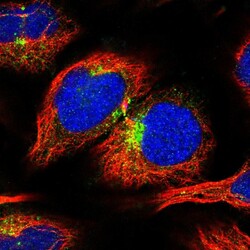Antibody data
- Antibody Data
- Antigen structure
- References [3]
- Comments [0]
- Validations
- Immunocytochemistry [1]
Submit
Validation data
Reference
Comment
Report error
- Product number
- HPA039319 - Provider product page

- Provider
- Atlas Antibodies
- Proper citation
- Atlas Antibodies Cat#HPA039319, RRID:AB_10673141
- Product name
- Anti-APLP2
- Antibody type
- Polyclonal
- Description
- Polyclonal Antibody against Human APLP2, Gene description: amyloid beta (A4) precursor-like protein 2, Alternative Gene Names: APPH, APPL2, Validated applications: ICC, IHC, Uniprot ID: Q06481, Storage: Store at +4°C for short term storage. Long time storage is recommended at -20°C.
- Reactivity
- Human
- Host
- Rabbit
- Conjugate
- Unconjugated
- Isotype
- IgG
- Vial size
- 100 µl
- Concentration
- 0.2 mg/ml
- Storage
- Store at +4°C for short term storage. Long time storage is recommended at -20°C.
- Handling
- The antibody solution should be gently mixed before use.
Submitted references Immuno-histochemical correlation of fibrosis-related markers with the desmoplastic reaction of the mesentery in small intestine neuroendocrine neoplasms.
An Integrative Data Mining and Omics-Based Translational Model for the Identification and Validation of Oncogenic Biomarkers of Pancreatic Cancer
The nuclear splicing factor RNA binding motif 5 promotes caspase activation in human neuronal cells, and increases after traumatic brain injury in mice.
Bösch F, Altendorf-Hofmann A, Koliogiannis V, Ilhan H, Jacob S, Pretzsch E, Nölting S, Werner J, Klauschen F, Auernhammer CJ, Angele MK, Knösel T
Journal of cancer research and clinical oncology 2023 May;149(5):1895-1903
Journal of cancer research and clinical oncology 2023 May;149(5):1895-1903
An Integrative Data Mining and Omics-Based Translational Model for the Identification and Validation of Oncogenic Biomarkers of Pancreatic Cancer
Long N, Jung K, Anh N, Yan H, Nghi T, Park S, Yoon S, Min J, Kim H, Lim J, Kim J, Lim J, Lee S, Hong S, Kwon S
Cancers 2019;11(2):155
Cancers 2019;11(2):155
The nuclear splicing factor RNA binding motif 5 promotes caspase activation in human neuronal cells, and increases after traumatic brain injury in mice.
Jackson TC, Du L, Janesko-Feldman K, Vagni VA, Dezfulian C, Poloyac SM, Jackson EK, Clark RS, Kochanek PM
Journal of cerebral blood flow and metabolism : official journal of the International Society of Cerebral Blood Flow and Metabolism 2015 Mar 31;35(4):655-66
Journal of cerebral blood flow and metabolism : official journal of the International Society of Cerebral Blood Flow and Metabolism 2015 Mar 31;35(4):655-66
No comments: Submit comment
Supportive validation
- Submitted by
- Atlas Antibodies (provider)
- Main image

- Experimental details
- Immunofluorescent staining of human cell line U-2 OS shows localization to vesicles.
- Sample type
- Human
 Explore
Explore Validate
Validate Learn
Learn Immunocytochemistry
Immunocytochemistry Immunohistochemistry
Immunohistochemistry